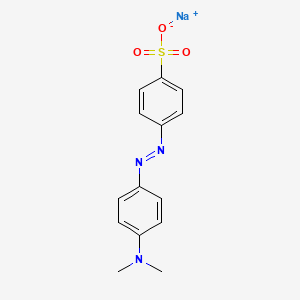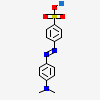Methyl orange
- METHYL ORANGE
- 547-58-0
- Orange III
- MethylOrange
- Acid Orange 52
- Create:2008-02-05
- Modify:2025-01-04

- C.I. 13025
- C.I. Acid Orange 52
- C.I. Acid Orange-52
- C.I.-13025
- Gold Orange
- helianthine
- methyl orange
- methyl orange, 35S-labeled
- methyl orange, sodium salt
- p(((p-dimethylamino)phenyl)azo)benzenesulfonic acid sodium salt
- Tropaeolin D
- METHYL ORANGE
- 547-58-0
- Orange III
- MethylOrange
- Acid Orange 52
- Helianthine B
- C.I. Acid Orange 52
- Gold Orange
- Eniamethyl Orange
- Helianthine
- Helianthin
- Tropaeolin D
- MFCD00007502
- C.I. 13025
- Methyl Orange B
- Kca Methyl Orange
- Sodium p-dimethylaminoazobenzenesulfonate
- 60305-61-5
- Benzenesulfonic acid, 4-((4-(dimethylamino)phenyl)azo)-, sodium salt
- Benzenesulfonic acid, 4-[[4-(dimethylamino)phenyl]azo]-, sodium salt
- Methyl Orange (C.I. 13025)
- 6B4TC34456
- Sodium 4'-(dimethylamino)azobenzene-4-sulfonate
- sodium (E)-4-((4-(dimethylamino)phenyl)diazenyl)benzenesulfonate
- Methyloranz [Czech]
- Oranz III [Czech]
- CI Acid Orange 52
- Orange III (VAN)
- Methyloranz
- Methyl orange, ACS reagent
- sodium;4-[[4-(dimethylamino)phenyl]diazenyl]benzenesulfonate
- Oranz methylova
- 4-[4-(Dimethylamino)phenylazo]benzenesulfonic acid sodium salt
- Oranz methylova [Czech]
- 4-((4-(Dimethylamino)phenyl)diazenyl)benzenesulfonic acid, sodium salt
- Oranz kysela 52 [Czech]
- Oranz III
- Oranz kysela 52
- NSC-9416
- HSDB 4322
- Benzenesulfonic acid, 4-[[4-(dimethylamino)phenyl]azo]-, sodium salt,(E)-
- 4-Dimethylaminoazobenzene-4'-sulphonic acid sodium salt
- NSC 9416
- EINECS 208-925-3
- p-((p-(Dimethylamino)phenyl)azo)benzenesulfonic acid sodium salt
- CI 13025
- AI3-09086
- CCRIS 9454
- UNII-6B4TC34456
- Sodium 4-(dimethylamino)azobenzene-4'-sulfonate
- Sodium 4-(4-dimethylaminophenylazo)benzenesulphonate
- Sodium 4-(4-(dimethylamino)phenylazo)benzenesulfonate
- Methyl Orange solution
- Methyl orange indicator
- Methylorange sodium salt
- AI 3-09086
- METHYL ORANGE [MI]
- SCHEMBL18892
- SCHEMBL18893
- METHYL ORANGE [HSDB]
- DTXSID60883437
- Benzenesulfonic acid, p-((p-(dimethylamino)phenyl)azo)-, sodium salt
- AKOS001115953
- AKOS015902984
- AKOS015950686
- AKOS024301609
- SY010301
- DB-052645
- HY-118907
- CS-0077680
- M0017
- M0489
- NS00080614
- EN300-18774
- Q409196
- 4-Dimethylaminoazobenzene-4'-sulfonic acid,sodium salt
- Z90123631
- F0347-4903
- 4-(((4-DIMETHYLAMINO)PHENYL)AZO)BENZENESULFONIC ACID SODIUM SALT
- Sodium 4-[(E)-2-[4-(dimethylamino)phenyl]-diazen-1-yl]benzene-1-sulfonate
- sodium 4-[(E)-2-[4-(dimethylamino)phenyl]diazen-1-yl]benzene-1-sulfonate
- sodium 4-{2-[4-(dimethylamino)phenyl]diazen-1-yl}benzene-1-sulfonate
- 4-(2-(4-(DIMETHYLAMINO)PHENYL)DIAZENYL)BENZENESULFONIC ACID SODIUM SALT (1:1)
- Benzenesulfonic acid, 4-(2-(4-(dimethylamino)phenyl)diazenyl)-, sodium salt (1:1)
Information on 1 consumer products that contain Methyl Orange in the following categories is provided:
• Auto Products

P264, P270, P301+P316, P321, P330, P405, and P501
(The corresponding statement to each P-code can be found at the GHS Classification page.)
Aggregated GHS information provided per 213 reports by companies from 4 notifications to the ECHA C&L Inventory.
Reported as not meeting GHS hazard criteria per 1 of 213 reports by companies. For more detailed information, please visit ECHA C&L website.
There are 3 notifications provided by 212 of 213 reports by companies with hazard statement code(s).
Information may vary between notifications depending on impurities, additives, and other factors. The percentage value in parenthesis indicates the notified classification ratio from companies that provide hazard codes. Only hazard codes with percentage values above 10% are shown.
Excerpt from ERG Guide 151 [Substances - Toxic (Non-Combustible)]:
Highly toxic, may be fatal if inhaled, ingested or absorbed through skin. Avoid any skin contact. Fire may produce irritating, corrosive and/or toxic gases. Runoff from fire control or dilution water may be corrosive and/or toxic and cause environmental contamination. (ERG, 2024)
Excerpt from ERG Guide 151 [Substances - Toxic (Non-Combustible)]:
Non-combustible, substance itself does not burn but may decompose upon heating to produce corrosive and/or toxic fumes. Containers may explode when heated. Runoff may pollute waterways. (ERG, 2024)
EYES: First check the victim for contact lenses and remove if present. Flush victim's eyes with water or normal saline solution for 20 to 30 minutes while simultaneously calling a hospital or poison control center. Do not put any ointments, oils, or medication in the victim's eyes without specific instructions from a physician. IMMEDIATELY transport the victim after flushing eyes to a hospital even if no symptoms (such as redness or irritation) develop.
SKIN: IMMEDIATELY flood affected skin with water while removing and isolating all contaminated clothing. Gently wash all affected skin areas thoroughly with soap and water. If symptoms such as redness or irritation develop, IMMEDIATELY call a physician and be prepared to transport the victim to a hospital for treatment.
INHALATION: IMMEDIATELY leave the contaminated area; take deep breaths of fresh air. If symptoms (such as wheezing, coughing, shortness of breath, or burning in the mouth, throat, or chest) develop, call a physician and be prepared to transport the victim to a hospital. Provide proper respiratory protection to rescuers entering an unknown atmosphere. Whenever possible, Self-Contained Breathing Apparatus (SCBA) should be used; if not available, use a level of protection greater than or equal to that advised under Protective Clothing.
INGESTION: DO NOT INDUCE VOMITING. If the victim is conscious and not convulsing, give 1 or 2 glasses of water to dilute the chemical and IMMEDIATELY call a hospital or poison control center. Be prepared to transport the victim to a hospital if advised by a physician. If the victim is convulsing or unconscious, do not give anything by mouth, ensure that the victim's airway is open and lay the victim on his/her side with the head lower than the body. DO NOT INDUCE VOMITING. IMMEDIATELY transport the victim to a hospital. (NTP, 1992)
Excerpt from ERG Guide 151 [Substances - Toxic (Non-Combustible)]:
SMALL FIRE: Dry chemical, CO2 or water spray.
LARGE FIRE: Water spray, fog or regular foam. If it can be done safely, move undamaged containers away from the area around the fire. Dike runoff from fire control for later disposal. Avoid aiming straight or solid streams directly onto the product.
FIRE INVOLVING TANKS, RAIL TANK CARS OR HIGHWAY TANKS: Fight fire from maximum distance or use unmanned master stream devices or monitor nozzles. Do not get water inside containers. Cool containers with flooding quantities of water until well after fire is out. Withdraw immediately in case of rising sound from venting safety devices or discoloration of tank. ALWAYS stay away from tanks in direct contact with flames. For massive fire, use unmanned master stream devices or monitor nozzles; if this is impossible, withdraw from area and let fire burn. (ERG, 2024)
Excerpt from ERG Guide 151 [Substances - Toxic (Non-Combustible)]:
IMMEDIATE PRECAUTIONARY MEASURE: Isolate spill or leak area in all directions for at least 50 meters (150 feet) for liquids and at least 25 meters (75 feet) for solids.
SPILL: Increase the immediate precautionary measure distance, in the downwind direction, as necessary.
FIRE: If tank, rail tank car or highway tank is involved in a fire, ISOLATE for 800 meters (1/2 mile) in all directions; also, consider initial evacuation for 800 meters (1/2 mile) in all directions. (ERG, 2024)
SMALL SPILLS AND LEAKAGE: If you spill this chemical, FIRST REMOVE ALL SOURCES OF IGNITION, then dampen the solid spill material with toluene, then transfer the dampened material to a suitable container. Use absorbent paper dampened with toluene to pick up any remaining material. Your contaminated clothing and absorbent paper should be sealed in a vapor-tight plastic bag for eventual disposal. Solvent-wash all contaminated surfaces with toluene followed by washing with a soap and water solution. Do not reenter the contaminated area until the Safety Officer (or other responsible person) has verified that the area has been properly cleaned.
STORAGE PRECAUTIONS: You should store this material in a refrigerator. (NTP, 1992)
Patents are available for this chemical structure:
https://patentscope.wipo.int/search/en/result.jsf?inchikey=STZCRXQWRGQSJD-UHFFFAOYSA-M
Patents are available for this chemical structure:
https://patentscope.wipo.int/search/en/result.jsf?inchikey=STZCRXQWRGQSJD-GEEYTBSJSA-M
- Australian Industrial Chemicals Introduction Scheme (AICIS)Benzenesulfonic acid, 4-[[4-(dimethylamino)phenyl]azo]-, sodium salthttps://services.industrialchemicals.gov.au/search-inventory/
- CAMEO ChemicalsLICENSECAMEO Chemicals and all other CAMEO products are available at no charge to those organizations and individuals (recipients) responsible for the safe handling of chemicals. However, some of the chemical data itself is subject to the copyright restrictions of the companies or organizations that provided the data.https://cameochemicals.noaa.gov/help/reference/terms_and_conditions.htm?d_f=false4-DIMETHYLAMINOAZOBENZENE-4-SULFONIC ACID, SODIUM SALThttps://cameochemicals.noaa.gov/chemical/20226CAMEO Chemical Reactivity Classificationhttps://cameochemicals.noaa.gov/browse/react
- ChemIDplusChemIDplus Chemical Information Classificationhttps://pubchem.ncbi.nlm.nih.gov/source/ChemIDplus
- EPA Chemicals under the TSCABenzenesulfonic acid, 4-[2-[4-(dimethylamino)phenyl]diazenyl]-, sodium salt (1:1)https://www.epa.gov/chemicals-under-tscaEPA TSCA Classificationhttps://www.epa.gov/tsca-inventory
- EPA DSSToxC.I. Acid Orange 52https://comptox.epa.gov/dashboard/DTXSID60883437CompTox Chemicals Dashboard Chemical Listshttps://comptox.epa.gov/dashboard/chemical-lists/
- European Chemicals Agency (ECHA)LICENSEUse of the information, documents and data from the ECHA website is subject to the terms and conditions of this Legal Notice, and subject to other binding limitations provided for under applicable law, the information, documents and data made available on the ECHA website may be reproduced, distributed and/or used, totally or in part, for non-commercial purposes provided that ECHA is acknowledged as the source: "Source: European Chemicals Agency, http://echa.europa.eu/". Such acknowledgement must be included in each copy of the material. ECHA permits and encourages organisations and individuals to create links to the ECHA website under the following cumulative conditions: Links can only be made to webpages that provide a link to the Legal Notice page.https://echa.europa.eu/web/guest/legal-noticeSodium 4-(4-dimethylaminophenylazo)benzenesulphonatehttps://echa.europa.eu/substance-information/-/substanceinfo/100.008.115Sodium 4-(4-dimethylaminophenylazo)benzenesulphonate (EC: 208-925-3)https://echa.europa.eu/information-on-chemicals/cl-inventory-database/-/discli/details/5788
- FDA Global Substance Registration System (GSRS)LICENSEUnless otherwise noted, the contents of the FDA website (www.fda.gov), both text and graphics, are not copyrighted. They are in the public domain and may be republished, reprinted and otherwise used freely by anyone without the need to obtain permission from FDA. Credit to the U.S. Food and Drug Administration as the source is appreciated but not required.https://www.fda.gov/about-fda/about-website/website-policies#linking
- Hazardous Substances Data Bank (HSDB)METHYL ORANGEhttps://pubchem.ncbi.nlm.nih.gov/source/hsdb/4322
- New Zealand Environmental Protection Authority (EPA)LICENSEThis work is licensed under the Creative Commons Attribution-ShareAlike 4.0 International licence.https://www.epa.govt.nz/about-this-site/general-copyright-statement/
- Haz-Map, Information on Hazardous Chemicals and Occupational DiseasesLICENSECopyright (c) 2022 Haz-Map(R). All rights reserved. Unless otherwise indicated, all materials from Haz-Map are copyrighted by Haz-Map(R). No part of these materials, either text or image may be used for any purpose other than for personal use. Therefore, reproduction, modification, storage in a retrieval system or retransmission, in any form or by any means, electronic, mechanical or otherwise, for reasons other than personal use, is strictly prohibited without prior written permission.https://haz-map.com/AboutMethyl orangehttps://haz-map.com/Agents/1970
- Consumer Product Information Database (CPID)LICENSECopyright (c) 2024 DeLima Associates. All rights reserved. Unless otherwise indicated, all materials from CPID are copyrighted by DeLima Associates. No part of these materials, either text or image may be used for any purpose other than for personal use. Therefore, reproduction, modification, storage in a retrieval system or retransmission, in any form or by any means, electronic, mechanical or otherwise, for reasons other than personal use, is strictly prohibited without prior written permission.https://www.whatsinproducts.com/contents/view/1/6Consumer Products Category Classificationhttps://www.whatsinproducts.com/
- DailyMed
- IUPAC Digitized pKa DatasetMethyl Orangehttps://github.com/IUPAC/Dissociation-Constants
- Japan Chemical Substance Dictionary (Nikkaji)
- NORMAN Suspect List ExchangeLICENSEData: CC-BY 4.0; Code (hosted by ECI, LCSB): Artistic-2.0https://creativecommons.org/licenses/by/4.0/Methyl orangeNORMAN Suspect List Exchange Classificationhttps://www.norman-network.com/nds/SLE/
- Springer Nature
- Thieme ChemistryLICENSEThe Thieme Chemistry contribution within PubChem is provided under a CC-BY-NC-ND 4.0 license, unless otherwise stated.https://creativecommons.org/licenses/by-nc-nd/4.0/
- Wikidatamethyl orangehttps://www.wikidata.org/wiki/Q409196
- WikipediaMethyl orangehttps://en.wikipedia.org/wiki/Methyl_orange
- Wiley
- PubChem
- Medical Subject Headings (MeSH)LICENSEWorks produced by the U.S. government are not subject to copyright protection in the United States. Any such works found on National Library of Medicine (NLM) Web sites may be freely used or reproduced without permission in the U.S.https://www.nlm.nih.gov/copyright.htmlmethyl orangehttps://www.ncbi.nlm.nih.gov/mesh/67100258Indicators and Reagentshttps://www.ncbi.nlm.nih.gov/mesh/68007202
- GHS Classification (UNECE)GHS Classification Treehttp://www.unece.org/trans/danger/publi/ghs/ghs_welcome_e.html
- EPA Substance Registry ServicesEPA SRS List Classificationhttps://sor.epa.gov/sor_internet/registry/substreg/LandingPage.do
- MolGenieMolGenie Organic Chemistry Ontologyhttps://github.com/MolGenie/ontology/
- PATENTSCOPE (WIPO)SID 396707396https://pubchem.ncbi.nlm.nih.gov/substance/396707396SID 403387700https://pubchem.ncbi.nlm.nih.gov/substance/403387700


 CID 11037 (Benzenesulfonic acid, 4-[[4-(dimethylamino)phenyl]azo]-)
CID 11037 (Benzenesulfonic acid, 4-[[4-(dimethylamino)phenyl]azo]-) CID 5360545 (Sodium)
CID 5360545 (Sodium)